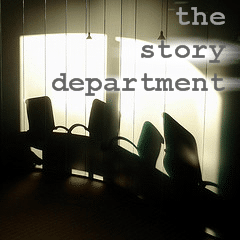A while ago, I posted about a story department for writers, like that of a Hollywood movie studio. Basically, it’s a place where we can find help identifying weaknesses, brainstorming new ideas, making the jokes better, getting the story structure right and more.

How this works:
The lucky volunteer submits whatever s/he wants help with: this could be the seed of an idea if you’re in the brainstorming phase, a query-length blurb if you’re looking for more specific brainstorming help or stuck in between plot points, a synopsis if you want structural advice, or even a scene or passage if you can’t quite put your finger on what’s not working. For maximum effectiveness, a short list of what you’re looking for is helpful.
I post the material on the appointed day. Then we, the kind, thoughtful and helpful readers and writers around here, put our minds to work. Think about it all day and come back with an insightful idea, or post the first thing that pops into your head.
Of course, the volunteer author doesn’t have to use anything we toss out—but now s/he isn’t the only one having to think of ideas. And even if we don’t come up with something specific to help the volunteer, maybe something one of us says will spark another idea and the story will take off again, magically healed 😉 . (The volunteer is more than welcome to engage in a discussion, of course, but we probably don’t need a full explanation of just why our ideas won’t work.)
The story
Today, I’m the volunteer again. I’m looking for help with one of those “little ideas,” a scene-level fix.
The setup:
Our bad guy (whom we may call . . . “Tom”) is trying to induce our heroine (“Nina”) to come somewhere with him to save our hero (“Johnny,” Nina’s fiancé). Nina has known Tom for years—and knows him well enough not to trust him. But when Tom shows Nina Johnny’s prized watch (or something else) that he never parts with, she knows something is wrong. Nina allows Tom to drive her car, and they’re leaving the garage at her building when one of her neighbors gets suspicious. When the neighbor starts to call the police, Tom shoots and kills him.
What I’m looking for:
- A way to keep Nina in the car after the gun goes off. Nina knows better than to go driving off with an armed murderer. I think Tom needs to physically restrain her in the car somehow.
- I’m also open to suggestions on Johnny’s prized, personally identifiable possession (something he’d be able to function without).
- If it helps, I think it’s not crucial that they use Nina’s car. (However, the neighbor is more likely to think something weird is going on if Tom’s driving Nina’s car. On the other hand, if you can give a reason for the neighbor to attract Tom’s attention and ire from Tom’s car, I’m open to that)
Want to participate? Jump in the comments! Want to volunteer? Send your material—including what you’re looking for—to storydept at JordanMcCollum.com. I’ll contact you to work out a date.
 I’m very impressed by their storytelling (especially Pixar). And the documentary offered some insight into their story process.
I’m very impressed by their storytelling (especially Pixar). And the documentary offered some insight into their story process. ideas, someone who knows the story and the characters as well as you do (and even if we have beta readers, few of us truly have that).
ideas, someone who knows the story and the characters as well as you do (and even if we have beta readers, few of us truly have that).